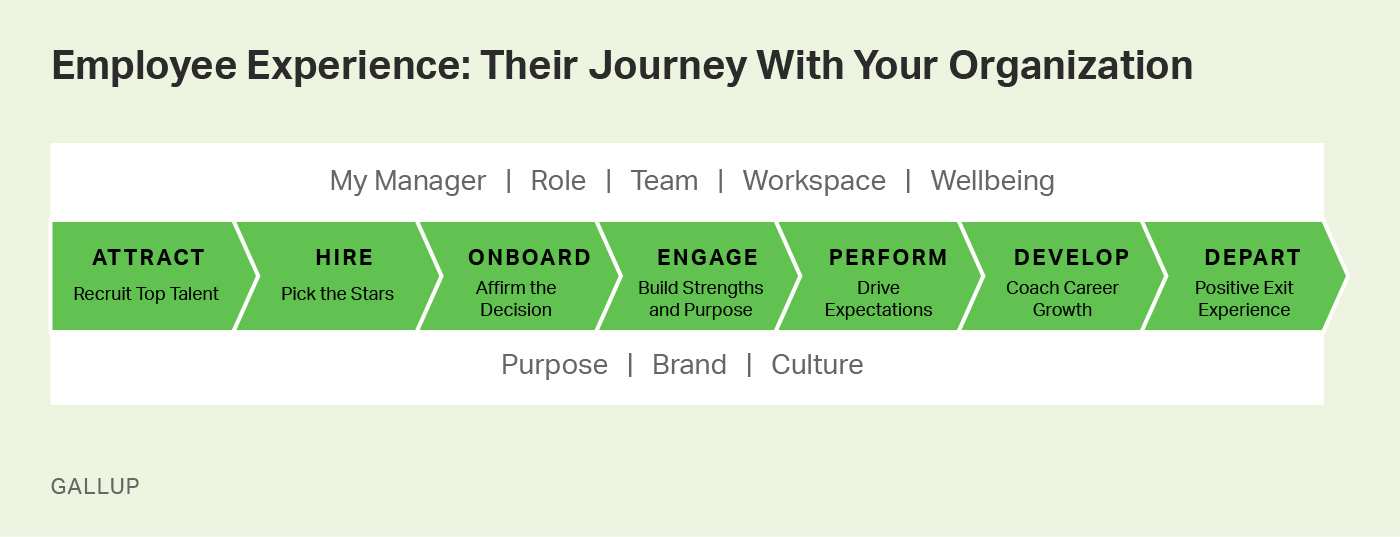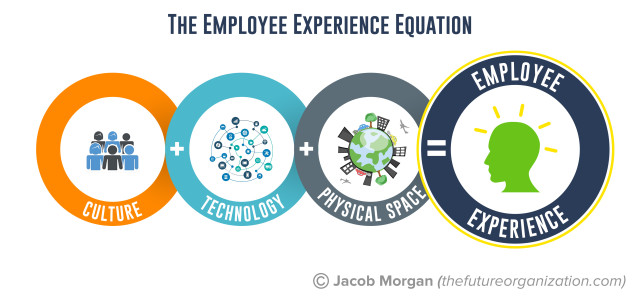Gartner’s 2019 Future of HR Survey reveals that creating a positive employee experience is now among the top three priorities for HR leaders.But why do business leaders start to care about employee experience?It comes down to the impact on the bottom line. Various studies (IBM’s, MIT’s, Jacob Morgan’s) have shown a strong link between employee experience and business performance metrics such as productivity, revenue, and profit.Gartner, however, found that only 29 percent of employees agree that “HR really understands what people like me need and want.” Without that key information, it will be challenging to improve the employee experience.Organizations of all sizes can use design thinking principles to create programs, services, and processes that provide positive employee experiences. Through design thinking, HR leaders can learn to empathize with employees to better define their needs and develop solutions that address them.
Why does the employee experience matter now?
There are several workforce factors that are driving organizations to make improving the employee experience a strategic priority.First, there are 1.4 million more jobs than unemployed people, creating a fierce war for talent across industries as organizations poach from one another.Millennials make up the largest segment in the workforce, and have higher expectations for their work experience. They seek meaning and purpose. The want flexible work arrangements. They also want coaching and mentoring, personal and career growth, consumer-grade tools to do their jobs, and more.And if they have a poor experience, you better believe that they will not hesitate to voice their displeasure on Glassdoor and social media platforms.Furthermore, investments in employee engagement initiatives continue to grow, yet have yielded little measurable impact. In fact, only 33 percent of the US workforce is engaged, hurting productivity and retention.

The good news is that there are progressive organizations like Facebook, Linkedin, Airbnb, and Adobe that understood the importance of a great employee experience...and have crafted a holistic employee experience for their employees to overcome those challenges.As a result, they have more success in building a talent pipeline, retaining top employees, and driving productivity and performance.But a great employee experience doesn’t have to be exclusive to large organizations. It doesn’t have to cost much to take care of your employees, although any investment in employee experience would certainly pay dividends in higher productivity and employee retention.
What are the benefits of investing in employee experience?
Some of the biggest, most successful brands in the world—like Facebook, Airbnb, Adobe, LinkedIn— invest in employee experience. That’s because a great employee experience has many benefits that impact the bottom line, as shown in various studies:
- Experiential companies, on average, have four times higher average profit per employee, 4.2 times profit in general, and 40 percent less turnover.
- Organizations that score in the top 25 percent on employee experience report three times the return on assets (ROA) and double the return on sales (ROS) compared to organizations in the bottom quartile. Increasing the employee experience score by a margin of 0.25 (on a five-point scale) corresponds to 0.86 percentage-point improvements in ROA and a 1.81 percentage-point improvement in ROS.
- Happy employees are up to 20 percent more productive.
- The most engaged teams have 41 percent lower absenteeism, 24 percent lower turnover, 10 percent higher customer metrics, 17 percent higher productivity, 10 percent higher sales, and 21 percent higher profitability.
What is the employee experience?
At the highest level, employee experience is everything that people encounter, observe, or feel over the course of their time with a company.Gallup's approach to creating a compelling employee experience centers on seven key stages where employees interact with their organization in a “pivotal way”.[caption id="attachment_2788" align="aligncenter" width="1400"]

Source: Gallup.com[/caption]Gallup also discovered that “an employee's interaction with their manager is one of the most important factors for success in all seven stages of the employee journey.”Jacob Morgan, a best-selling author, speaker, and thought leader on employee experience, believes employee experience is the “intersection of employee expectations, needs, and wants and the organizational design of those expectations, needs, and wants.”Jacob also added, “employee experience involves a complete redesign of the organization that puts employees at the center. In other words, instead of trying to force people to fit into outdated workplace practices, organizations must redesign their workplace practices to fit with their people.”
Employee experience involves a complete redesign of the organization that puts employees at the center. In other words, instead of trying to force people to fit into outdated workplace practices, organizations must redesign their workplace practices to fit with their people.”
How to craft a great employee experience
To understand what the employee experience is like, Jacob Morgan interviewed 150 psychologists, economists, and business leaders in various industries and sectors around the world. Based on those conversations, he identified three environments that have the biggest impact on the employee experience:

- The cultural environment: The cultural environment is about the feelings employees get while working for your organization.A great cultural environment ensures that employees feel valued, their health and well-being matter, they have a sense of purpose, meaning, and belonging, and they have opportunities to learn and grow. Things like recognition, listening to employee feedback, and mentoring are easy and free to implement. Other things like compensation and benefits, training and development, and perks require an investment, so they should be carefully considered and planned.Company culture should be unique to your organization, so be intentional about how you will craft it.
- The technological environment: The technological environment refers to the tools (hardware + software) employees use to get the job done.Modern employees want consumer-grade technology that enables them to get their jobs done more efficiently. This includes everything from hardware and software, to apps and peripherals. Moreover, technology should meet the employee’s needs, and not just the business’ requirements.A strong HR-IT partnership can help to ensure that employees have tools and software that are intuitive to use, and user-friendly.
- The physical environment: The physical environment refers to the actual work spaces in which employees work.A thoughtful workplace design can help employees feel happy and comfortable. This should include good air quality and lighting, comfortable temperature, multiple workspace options, ergonomic workspaces and equipment, beautiful office design, and flexible work arrangements.You know you’ve built a great physical environment when employees are proud to show their workplace to their friends and family.
When these things come together to form a great employee experience, you will have more engaged employees who will be inspired to do their best works.Unfortunately, while nearly 80 percent of executives rated employee experience very important or important, only 22 percent reported that their companies were excellent at building a differentiated employee experience.To help your employees perform at their best, most experts encourage you to observe and listen to deeply understand their challenges, wants, and needs. Tools like design thinking,employee journey mapping, and Employee Net Promoter Score (eNPS) can help!Involve your employees in the design of your employee experience by learning about the problems and challenges they face. Encourage everyone on your team to help you ideate solutions, and to provide feedback when you roll something out. This will help you create a unique employee experience that meets your employees’ needs.
Final thoughts on employee experience
I've had a few bad experiences working for companies that treated me like a replaceable part in my career. Those experiences left a bad taste in my mouth for years. So, I am encouraged that there’s an increased focus on the employee experience today.Building a great product or service is no longer enough to sustain business success in today's business environment.Technology, manufacturing operations, and product features can be copied.Your employees are the most important asset. If they are engaged in their work and committed to the mission of your business, they will deliver higher performances and take better care of the customers.Deloitte shared some interesting insights from an executive, “We used to prioritize our stakeholders as shareholders first, customers second, and employees third. We now realize we had it backward. If we put employees first, they in turn take care of our customers, and they in turn take care of our shareholders.”Small and medium-sized businesses, who already are facing a big challenge in attracting and retaining qualified workers, must prioritize employee experience now before it's too late.By addressing the areas that have an impact on the employee experience, your organization will have more success attracting and retaining top talent, and building a workforce that is innovative, engaged, and high-performing.


